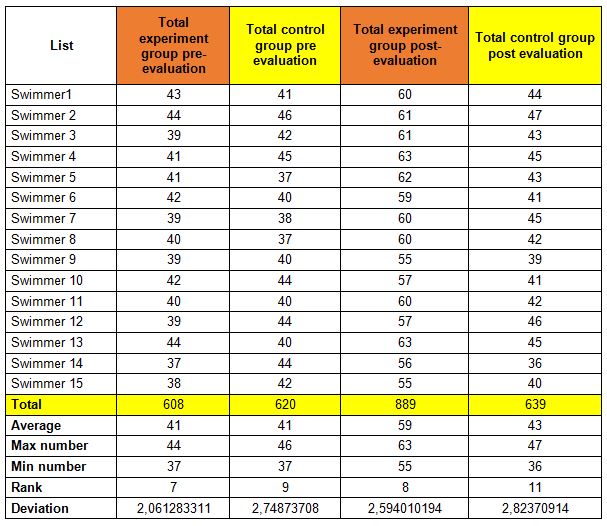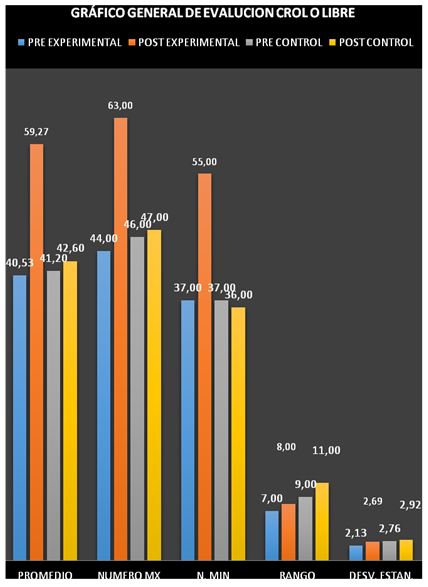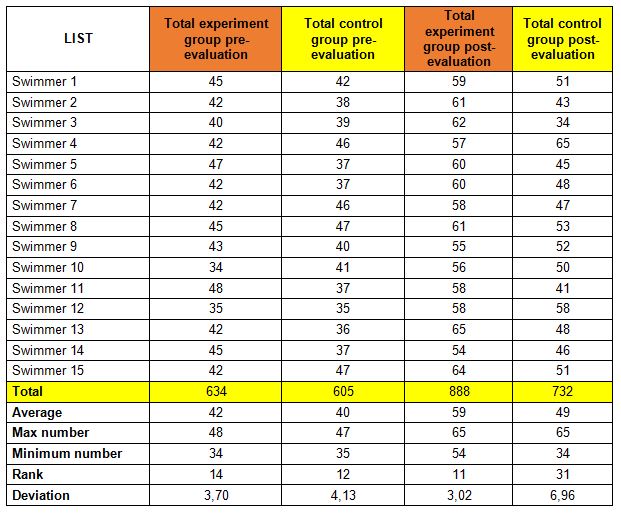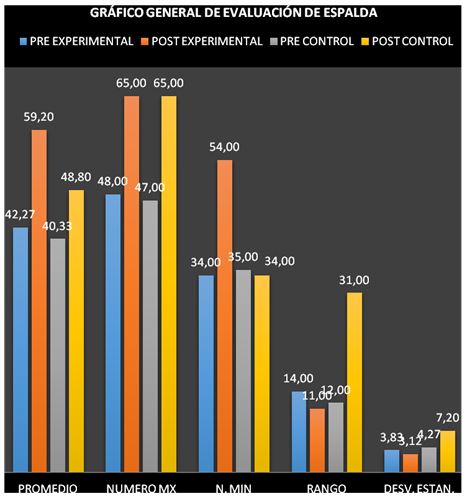Introduction
The proposal to elaborate ludic activities for beginning swimmers aims to
determine the influence in the development of teaching and compare it to the
traditional method in order to improve this process directly related to the
wellbeing of the child, their motivation to attend to class, the frequency and
permanence.
According to Ramos Rodríguez and collaborators (2004), the recreational
games carried out in rivers, pools or beaches (with precaution) provide more fun
than any other recreational activity; confidence in themselves and the
opportunity to help others in case of danger; develop reliability and security;
and contribute to achieve good health through physical exercise.
In addition, swimming is in great advantage compared to other sports since it
can be practiced by anyone and even its learning can take place at any age
(Moreno & Sanmartín, 1998; Ketcham, Lucarelli, Miravete, & Roebuck,
2012; Herrera, & Barbero, 2013).
Due to the abovementioned, we found that there are swimming programs for babies,
children, youths, adults, elders and for handicapped people (Graćanin,
Medjedović, Mekić, Mavrić, & Obreslikov, 2012; Gallego,
Aguilar, Cangas, Torrecillas, Javier, Justo, & Mañas, 2012).
However, for many people, swimming is a sport that favors personal development
in all dimensions.
In the case of our society, the teaching of swimming begins at the age of six
(Garcia, & Ramírez, 2014), without taking into account that a big
percentage of the Ecuadorian population hasn’t had access to a swimming lesson
and does not even know how to swim.
The role of the professor during swimming sessions consists also on the capacity
to favour and increase the motivation of the students (Suárez, Zoghbi, &
Aguiar, 2013; Júlio, Samuel, João, & Luís, 2014) due to the relationship
the child develops during the activities and the trend to physical inactivity.
In the theory and methodology of the future swimmer’s training, there are
several methods (Melo, Moreno, & Aguirre, 2012) to apply during the
teaching-learning process, for which they adapt in order to achieve a high sport
performance in a short period of time (Morán-Navarro, 2016), making emphasis in
the individualization of the loads according to the characteristics of the
athlete (Álvarez, Morales, & Artile, 2012), as in the case of high
intensity trainings (Eguía, Guzmán, & Soto, 2013), for which are compared
different planning models such as traditional and inverse periodization, setting
which is the more ideal, as it was stated in Arroyo, Clemente, González, Ramos,
& Sortwell (2014) an aspect that is even experienced in other sports
(Paucar, Pisuña, Calero, Coral, Loachamin y Rodríguez, 2017).
The search for sport improvement implies a redesign of strategies that should
adapt to the characteristics of the subject, for which several successful
training models are not infallible in all cases. Such is the case of the
technical training with lack of motivation.
Although the modelling of the training in initial stages prioritizes the
technique (Mitchell, Oslin, & Griffin, 2013), it must be accompanied by
incentives for the athlete not to have a motivational gap that leads them to
sport defection; therefore it is inferred that the higher the level of
motivation the more technical learning.
One of the strategies that might influence the technical learning of the swimmer
is related to physical and recreational tasks, more related to physical activity
than to sport training. The idea is based on the recreational component that
favors the motivation of the students regardless the sport (Kondric, Sindik,
Furjan, & Schiefler, 2013; Ball, Bice, & Parry, 2014), since motivation
per se is an essential factor in the loss of interest towards the practice of
physical activities and sports, as affirmed by Kondakov, Kopeikina, Balysheva,
Usatov, & Skrug (2015). For that reason, the game as a priority method in
recreation, can serve as a motivational element in the beginning of the speed
training of the swimmer (Domínguez, 2012), as well as other training aspects.
On the other hand, the traditional aspect leads training to deepen in the
implementation of intensive physical capabilities adapted to the needs of the
athlete, according to their biological and chronological age (Olbrecht, 2015;
Papoti, & et al, 2017).
Given the aforementioned, this paper aims to determine which of the methods
(traditional or physical-recreational) improves the best the performance of the
Crawl and Backstroke techniques in junior swimmers of the Educoach Club in
Sangolquí, Ecuador.
Methods
The present research paper is experimental, since a program of water ludic
activities will be implemented in order to enhance the learning of crawl and
backstroke swimming techniques, and at the same time will be applied the
corresponding evaluations to check the effectiveness of the program.
The research is carried out at Educoach club located in the city of Sangolquí,
province of Pichincha in 2015. The sample includes 30 children, which will be
all undergone to study: 15 for the experiment group (physical-recreational
proposal), and 15 for the control group (traditional method). The evaluation
methods are fact sheets created by the professors of the Educoach Club. To check
the best training methods for the technical training, is applied a test to
assess the performance before and after the six-month proposal. To determine the
existence or not of significant differences is applied the Wilcoxon signed-rank
test (p≤0,05) for two related samples, comparing the initial tests
(pre-test) with the final tests (post-test) of the control and experiment group
separated.
Given the existence of significant differences when applying both training
methods in the case of the backstroke technique, was applied the Mann-Whitney U
test for two independent samples (p≤0,05) comparing the results of the
pre-test in both groups (experiment and control).
Methodology
It was made the following evaluation sheet for different techniques, taking into
account certain aspects such as:
-
Position
of the body.
-
Movement
of the legs.
-
Movement
of the arms.
These aspects have their respective assessment items, for their evaluation was
stated a reference score in an effectiveness scale in the execution of the
specific indicator in several repetitions of the complete technique where:
-
One
point, the execution of the technique is BAD.
-
Two
points, the execution of the technique is AVERAGE.
-
Three
points, the execution of the technique is GOOD.
-
Four
points, the execution of the technique is VERY GOOD.
-
Five
points, the execution of the technique is EXCELLENT.
Table
1. Observation Form for the evaluation of the Crawl and Backstroke
techniques (In Spanish)

The evaluation procedure was made taking into account the swimming techniques in
a 50 metre distance. The evaluation team is made up by 3 certified swimming
professors.
The program consisted on planned contents that develop through ludic adaptations
with and without materials as didactic resources to teach swimming.
The technical contents chosen for the program respond to the goals of the
teaching-learning process and the improvement of the crawl and backstroke
techniques, using as instrument aquatic ludic activities.
Results
and discussion
Table 2 shows the values obtained in a pre-evaluation and a post-evaluation
applied on both groups.
Table
2. Data obtained in the pre-test and the post-test for the evaluation of the
crawl or freestyle technique

The comparison of the pre-test with the post-test in the experiment group
determined the existence of significant differences (p=0,001), as it is
demonstrated when applying the Wilcoxon Signed-rank test, existing 15 positive
ranks in the evaluation of the Crawl or freestyle technique.
On the other hand, by comparing the data obtained before and after the
implementation of the traditional method (Control Group), there were found no
significant differences (p=0,175), showing 10 positive ranks, four negative
ranks and one draw, inferring that the traditional method did not improve the
performance of the technique.
Graphic
1. General analysis of the Crawl technique

Improvement average of the crawl technique:
the experiment group improves in near 20 percentage points in comparison to the
control group, whose improvement is minimal with almost one percentage point,
which shows that the experiment program had a favourable incidence in enhancing
the technique.
Table 3 shows the values of the pre-evaluation and the post-evaluation carried
out on the two groups in the backstroke technique.
Table
3. Data obtained in the pre-test and the post-test for the evaluation of the
Backstroke technique

The Wilcoxon signed rank test determined the existence of significant
differences (p=0,001) by comparing the pre-test and the post-test as part of the
experiment group that was undergone to the training proposal with a recreational
approach, existing 15 positive ranks out of 15 possible. On the other hand, the
comparison of the pre-test with the post-test in the control group (applied with
thetraditional training method), determined the existence of significant
differences (p=0,002), according to the Wilcoxon signed rank test, inferring a
substantial improvement of the backstroke with the traditional training.
Since both training methods determined substantial improvements in the
backstroke technique, it is worth comparing the results of the post-test in both
groups. The comparison with the Mann-Whitney Test determined the existence of
significant difference in the records of the backstroke performance (p=0,000),
but the experiment group showed a better average rank (21,67) than the control
group (9,33), which deducts that the experiment group improved the performance
in the backstroke technique much more than the control group. For the present
study, the training method with a recreational approach allowed improving the
technical performance more than the traditional method.
Graphic
2. General analysis of the backstroke technique

Average improvement in the backstroke technique:
the experiment group improves almost 17 percentage points in comparison to the
control group, whose improvement is near eight percentage points, which shows
that the physical-recreational program had a favourable incidence in correcting
the technique.
The results of the present paper, in the opinion of the authors, are related to
the motivational character of the physical-recreational sport practice
specialized in games or activities included in the experiment program, which in
the opinion of authors such as Ramos Rodríguez and collaborators (2004),
provide entertainment, self-confidence and reliability, as well as other useful
aspects to enhance initial teaching (Calero, 2013, 2014).
On the other hand and according to the amount of teaching swimming programs (Graćanin,
Medjedović, Mekić, Mavrić, & Obreslikov, 2012; Gallego,
Aguilar, Cangas, Torrecillas, Javier, Justo, & Mañas, 2012; Melo, Moreno,
& Aguirre, 2012), they can be classified in traditional or experimental as
the present case, in which is essential the implementation of pertinent actions
that favor the necessary motivation for learning and for the permanence of the
swimmer during the entire training process (Suárez, Zoghbi, & Aguiar, 2013;
Júlio, Samuel, João, & Luís, 2014).
It is precisely the motivating factor that allows strengthening in a short, and
mostly in a long term period, the sport performance, and it is necessary to
adapt the planning for a better assimilation of the content as soon as possible
(Morán-Navarro, 2016), making emphasis in the teaching of the technique in the
initial phases (Mitchell, Oslin, & Griffin, 2013). Hence the need of
establishing strategies and actions to achieve high sport performance in a short
period of time applying training models with a physical-recreational approach,
as the present paper describes.
As recommendations is indicated the following:
-
To
continue with the program of ludic activities for the correction of errors
in the Crawl and Backstroke techniques.
-
To
control and monitor the fact sheets modifying and adapting the according to
the age, features and needs.
-
The
programs planned and applied should be aimed at correcting the errors of
each technique, respecting the moments for implementation and evaluation for
an eventual improvement.
-
The
lessons should take place in a favorable environment for the work with kids,
especially in initial stages, where the love for swimming is being fostered,
since it cannot be seen as a punishment or an obligation.
-
The
swimming teachers should use games as a tool of learning, taking into
account that they are aimed at achieving a more attractive and dynamic
lesson.
Conclusions
-
In
the Crawl technique the experiment group improved almost 20 percentage
points in comparison to the control group, whose improvement is minimal with
almost one percentage point, which indicates that the program had a
favourable incidence in the correction of the technique, therefore the
comparison is significantly different.
-
In
the backstroke technique, the experiment group improves almost 17 percentage
points in comparison with the control group, whose improvement is near 8
percentage points; therefore the program had a favourable incidence on the
correction of the technique.
-
The
program of ludic activities had a favourable impact in the improvement of
the crawl and backstroke techniques, reason for which the hypothesis of the
paper is proven.
-
In
the backstroke technique the improvement was better than in the crawl
technique, both in the experiment and the control groups.
-
As
for the attendance and willingness of the children for the tasks, it was
higher in the experiment group.
-
During
the lessons, the motivation, participation and collaboration in general,
were higher in the experiment group.
Acknowledgements
To there search project: Gestión de competencias para publicaciones
científicas en estudiantes de pregrado y postgrado de la Universidad de las
Fuerzas Armadas ESPE.
Bibliography
-
Alvarez-Prieto,
M., Morales-Águila, A., & Artiles-Duarte, L. (2012). Modelo
teórico-metodológico para la individualización en la planificación del
entrenamiento deportivo en nadadores escolares (original). Revista
científica OLIMPIA, 9(32), 1-9.
-
Arroyo-Toledo,
J. J., Clemente, V. J., González-Rave, J. M., Ramos Campo, D. J., &
Sortwell, A. D. (2014). Comparación entre Periodización Tradicional y
Periodización Inversa: Rendimiento en Natación y Valores Específicos de
Fuerza. PubliCE Premium.
-
Ball,
J. W., Bice, M. R., & Parry, T. (2014). Adults’ Motivation for
Physical Activity: Differentiating Motives for Exercise, Sport, and
Recreation. Recreational Sports Journal, 38(2), 130-142.
-
Calero,
S. (2013). Nuevas tendencias mundiales en el proceso de dirección del
entrenamiento deportivo. Curso de Postgrado impartido en la Universidad
de Guayaquil. Instituto de Investigaciones, Ecuador.
-
Calero,
S. (2014). Fundamentos del entrenamiento optimizado. Cómo lograr un alto
rendimiento deportivo en el menor tiempo posible. Primer Congreso de
Fisioterapia y Deporte. Universidad del Valle de México.
-
Domínguez,
S. (2012). El juego como elemento motivador en el inicio del
entrenamiento de la velocidad en natación”. Facultad de Ciencias de
la Educación. Universidad FASTA
-
Eguía,
R. A. A., Guzmán, J. A. R., & Soto, M. E. (2013). Efectividad del
entrenamiento interválico de alta intensidad en la reducción de la
hemoglobina glicosilada en pacientes adultos con diabetes mellitus tipo 2. Diabetes
Research and Clinical Practice, 99(3), 120-129.
-
Gallego
Antonio, J., Aguilar Parra, J. M., Cangas Díaz, A. J., Torrecillas, L.,
Javier, J., Justo, C. F., & Mañas, I. M. (2012). Programa de natación
adaptada para personas mayores dependientes: beneficios psicológicos,
físicos y fisiológicos. Revista de psicología del deporte, 21(1),
0125-133.
-
García
Fandino, J., & Ramírez Palacios, J. E. (2014). Propuesta didáctica
sobre la enseñanza desde el enfoque praxeológico para la respiración en
la natación en niños de 6 a 8 años de Acuabello (Doctoral
dissertation, Corporación Universitaria Minuto de Dios).
-
Graćanin,
I., Medjedović, E., Mekić, H., Mavrić, F., & Obreslikov,
D. (2012). Effects of swimming within disabled persons. Research in
Kinesiology, 40(1).
-
Herrera,
E. M., & Barbero, M. D. S. M. (2013). El cuerpo, la expresión y el
medio acuático. Una experiencia integradora. Retos: nuevas tendencias en
educación física, deporte y recreación (24), 176-183.
-
Júlio,
M., Samuel, H., João, C., & Luís, D. (2014). Students' motivation to
practice sports in school between 9 to 14 years of basic education.
Journal of Physical Education and Sport, 14(4), 459.
-
Ketcham,
J. D., Lucarelli, C., Miravete, E. J., & Roebuck, M. C. (2012). Sinking,
swimming, or learning to swim in Medicare Part D. The American Economic
Review, 102(6), 2639-2673.
-
Kondakov,
V. L., Kopeikina, E. N., Balysheva, N. V., Usatov, A. N., & Skrug, D. A.
(2015). Causes of declining interest of students to employment physical
education and sports. Physical education of students, 19(1), 17-21.
-
Kondric,
M., Sindik, J., Furjan-Mandic, G., & Schiefler, B. (2013). Participation
motivation and student’s physical activity among sport students in three
countries. Journal of Sports Science and Medicine, 12(1), 10-18.
-
Melo,
L., Moreno, H., & Aguirre, H. H. (2012). Métodos de entrenamiento de
resistencia y fuerza empleados por los entrenadores para los IX juegos
sudamericanos, Medellín, Colombia, 2010. Revista UDCA Actualidad &
Divulgación Científica (Suplemento Especial Olimpismo), 15, 77-85.
-
Mitchell,
S. A., Oslin, J. L., & Griffin, L. L. (2013). Teaching sport concepts
and skills: A tactical games approach for ages 7 to 18. Champaign, Il:
Human Kinetics.
-
Morán-Navarro,
R. (2016). Adaptación de los métodos de entrenamiento a las
particularidades de la natación. SPORT TK. Revista EuroAmericana de
Ciencias del Deporte, 5(1), 75-79.
-
Moreno,
J. A., & Sanmartín, M. G. (1998). Bases metodológicas para el
aprendizaje de las actividades acuáticas educativas (Vol. 801).
Barcelona: Inde.
-
Olbrecht,
J. (2015). The science of winning: planning, periodizing and optimizing
swim training. F & G Partners.
-
Papoti,
M., da Silva, A. S., Kalva-Filho, C. A., Araujo, G. G., Santiago, V.,
Martins, L. B. et al. (2017). Tethered Swimming for the Evaluation and
Prescription of Resistance Training in Young Swimmers. International
Journal of Sports Medicine, 38(02), 125-133.
-
Paucar,
M.G., Pisuña, H.V., Calero, S., Coral, E.G., Loachamin, E.M., y Rodríguez,
M.P. (2017). Integrated training vs traditional training in senior taekwondo
practitioners. Lecturas: educación física y deportes. Buenos Aires,
Año 21, Nº 224, Enero de 2017. http://www.efdeportes.com/efd224/integrated-training-in-senior-taekwondo.htm
-
Ramos
Rodríguez Alejandro E. y colaboradores (2004). Juegos recreativos de
natación. Monografías.com.
-
Suárez
Acosta, M. Á., Zoghbi Manrique de Lara, P., & Aguiar Quintana, T.
(2013). Motivación del turista hacia la práctica de deportes náuticos: un
estudio en el destino turístico de Gran Canaria. Revista de análisis
turístico (15), 37-48.
Another articles in English

|
|
|
EFDeportes.com, Revista
Digital · Año 22 · N° 227 | Buenos Aires,
Abril de 2017
Lecturas: Educación Física y Deportes - ISSN 1514-3465 - © 1997-2017 Derechos reservados
|





